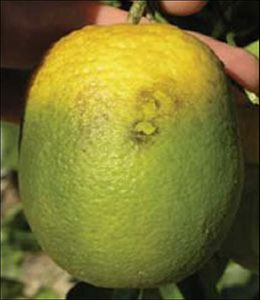Citrus Greening FAQ

A citrus leaf showing signs of infection.
It seems news agencies everywhere are discussing citrus greening and the effect it's having on Florida’s citrus industry. While many people know that citrus greening is ravaging citrus trees, there is some confusion as to what citrus greening actually is.
What is citrus greening?
Greening is a devastating citrus disease which results in decreased crop yields and the eventual death of infected trees. World-wide, the common name Huanglongbing (HLB) is used when discussing citrus greening. Huanglongbing is the name given to the disease in the mid-1900s by Chinese researcher Lin Kung Hsiang which translates to yellow dragon disease. This name is a reference to the yellow shoots that grow on infected trees; HLB is an abbreviation of the Chinese name.
HLB infection eventually renders infected plants completely unproductive. This, coupled with the lack of treatment for HLB makes this disease particularly devastating to both commercial citrus growers and homeowners growing citrus.
How is HLB spread?
HLB is caused by a bacterium which is transmitted from tree to tree by the Asian citrus psyllid. Psyllids become infected with the HLB bacterium by feeding on an infected tree. When the psyllid moves on to feed on an uninfected tree, the HLB bacterium is transmitted to the uninfected tree. There have also been documented cases of HLB transmitted by grafting, although this form of transmission is far less common.
The movement of infected trees also contributes to the spread of HLB. While the Asian citrus psyllid is the only way the bacterium can be transmitted from tree to tree, moving an infected tree can bring the bacteria into an area where it did not previously exist. From there, the Asian citrus psyllid will be able to spread the disease further.
Where has HLB been found?
HLB is found throughout Florida, as well as Louisiana, South Carolina, California, Georgia, and Texas . HLB has also seriously affected citrus production in areas around the world including Asia, Africa, the Indian subcontinent, the Arabian Peninsula, islands in the Indian Ocean, and Brazil.
Are all citrus trees susceptible to HLB?
HLB is capable of infecting virtually all species of citrus including various species, cultivars, hybrids, and even some citrus relatives. Sweet oranges, mandarins (tangerines), and mandarin hybrids (tangelos) are the most susceptible to HLB. Lemons, grapefruit, pummelos, and sour oranges trees, while slightly less susceptible, become unproductive when infected with HLB. Mexican lime, trifoliate orange, and some trifoliate orange hybrids are more tolerant of HLB infection and trees may only show some leaf symptoms.
What are the symptoms of HLB infection?
Citrus greening symptoms can be observed year-round; however, they are most visible from September to March. Symptoms of citrus greening are more easily observed in shade or on overcast days.
Leaf symptoms
HLB receives its name from one of symptoms of the disease, the yellowing of the leaves on a single branch or shoot. Blotchy mottle, random pattern of yellowing on leaves that is not the same on the right and left sides of the leaf midvein, is one of the best ways to identify HLB infected trees.
As HLB continues to infect a tree you may notice the spreading of yellow leaves, vein corking, and green islands on leaves.

One symptom: Fruit remain green at blossom end.
Fruit symptoms
Fruit can show signs of HLB infection both inside and out. On the outside, fruits may be lopsided or oblong in shape, they may be smaller than normal fruits, and they may change color abnormally turning orange near the stem and staying green at the blossom end. Internally the fruits of an HLB infected tree may have aborted seeds, a curved central core, a yellow stain beneath the calyx button, or an off flavor.
Overall tree appearance
Overall, trees infected with HLB may exhibit yellow shoots with upright narrow leaves, shoot die back, sparse foliation, a thin canopy, stunting, off-season bloom, or an overall yellow appearance.
What can I do if I think my tree is infected with HLB?
Contact your local Extension office for information on what to do about your tree. They will be able to help you determine if your tree is infected with HLB. Most Extension offices will ask you to send in digital images of your infected tree.
Is there a treatment for trees infected with HLB?
There is no treatment for trees with HLB. Infected trees, when they become unproductive, are usually destroyed to minimize further spread of the bacterium. If you have an HLB infected tree in your yard, contact your county Extension office for information on how to dispose of your tree safely.
What is being done to stop the spread of HLB?
Researchers throughout Florida and around the world are racing to find a way to stop the spread and combat HLB. As researchers continue to study HLB, psyllid control measures are being promoted to help prevent the further spread of the disease. Additionally, quarantines have been put in place to restrict the movement of infected and potentially infected trees.
The UF/IFAS Citrus in the Home Landscape initiative is designed to encourage Florida residents to once again grow citrus in their home landscapes. UF/IFAS researchers are working to translate discoveries they are finding from their work for the commercial citrus industry fighting the devastating Huanglongbing (citrus greening) disease to work for home gardeners. From breeding new HLB-tolerant citrus varieties, to supporting UF/IFAS Extension agents growing citrus in demonstration gardens, to providing trees for community give aways and plant sales and working to educate the over 5000 UF/IFAS Extension Master Gardener Volunteers on the latest techniques, we are working to support Florida’s citrus industry continue to be the leader is growing the world’s best citrus.
Reviewed by Dr. Stephen Futch, Extension Agent IV, the UF/IFAS Citrus Research and Education Center.
Also on Gardening Solutions
More from UF/IFAS
- UF/IFAS Citrus in the Home Landscape website
- Citrus Greening Myths and Facts--UF/IFAS Extension Blogs

